#Yasuyoshi Tokuma
Text

The studio was founded on June 15, 1985, in Tokyo (Japan) by Hayao Miyazaki, Toshio Suzuki, Isao Takahata and Yasuyoshi Tokuma. HAPPY BIRTHDAY STUDIO GHIBLI ❤ 🎂
6 notes
·
View notes
Text
Timelessness of Studio Ghibli
Aubrey, animation, shares the beauty of Japanese animation films from #StudioGhibli and the deeper messages that are enjoyed by both kids and adults alike. Keep an ear out for news about their new animation coming out later this year. #MarywoodArt
Animation has changed a great deal in the last few decades. What was once considered to be a children’s genre has evolved into a medium for stories of all kinds, and I believe this is due in part to the works of Studio Ghibli. Studio Ghibli is a Japanese animation studio, founded in 1985 by Hayao Miyazaki, Toshio Suzuki, Isao Takahata, and Yasuyoshi Tokuma. They are responsible for almost two…
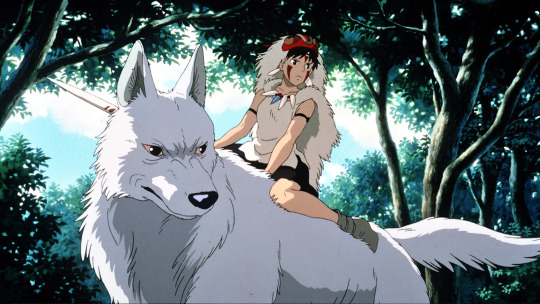
View On WordPress
#Animation#Art#burnout#environmentalism#film#Illustration#inspiration#kiki&039;s delivery service#Marywood Art#Marywood Art Department#Marywood University#Marywood University Art Department#princess mononoke#self care#studio ghibli#Where Creativity Works
1 note
·
View note
Text
Inspiration For the Project
youtube
So my friends saw this film at the Manchester animation festival 2022, I, unfortunately, could not make it. However, they kindly shared the trailer with me since when explaining my project it reminded them of this film. I would say we have very similar ideas about using wood however it is much different to mine. As I have an emphasis on the environment. I like the aesthetic of wood being carved in a stop-motion manner it makes it feel organic rather than 2D, and it draws the audience into the environment as though you could touch it. I would like to try and engage a similar effect in world-building however, my desire is to have a burnt aesthetic instead.
I do wish I had the opportunity to go as I was not able to stream this at home.
youtube
I would say I, of course, have to include William Kentridge as an inspiration for my work since he is using a non-traditional form of medium to make animation with charcoals. He is a South African artist, now 67 years old with several exhibitions in several museums around the world, recently he had one in London that I was unable to attend. He works within many mediums with a political, science, literature and history ground within them. In 2016 he created a centre in his home town called Less Good Idea to create a space for experimentation and creativity whilst holding workshops, public performances and mentorship. He is also a recipient of honorary doctorates.
He is an inspiration because I found enjoyment from using charcoals through him and his expressive medium. And try to replicate this has been fun through my experiments. Its artwork intrigues me about how it can make art move and further express an emotion. It has a gritty sense of realism and humanity which I also desire to express within my work.
Jodie Mack
English born (1983, Uk London) American woman, experimental film maker and animator. Attending the Florida university for the MFA in film, video, and new media at the school of art institute of chicago and teaches at Dartmouth College.
I choose her for my research because of her in-depth abstract experimental animated films. I love to play and push boundaries and so does she.
Most importantly her creative chaos comes from her exploration of pattern, place and life. I will say however I was not able to recreate a similar experiment. However, it has helped frame what experimental can be.

Hayao Miyazaki & Studio Ghibli
Created from three men, Hayao Miyazaki, Isao Takahata, Toshio Suzuki. ( there was a fourth guy Yasuyoshi Tokuma, executive producer owning the parent organisation to studio ghibli. but he has passed away, and it was only recently that Isao passed. He wasn’t very prominently seen, but a close friend to Hayao)
The studio was founded June 15th 1985, tokyo, by themselves. Including there music composer Joe Hisaishi.
They’ve created so many films, even Hayao’s son was involved directing a few movies. (And i have watched nearly all of them apart from the ones in the museum that are stricted). The one movire that signified to the western world and Disney was Spirited away, winning an Academy Award for best Animated Feature at the 75th Academy awards. Making it the first of its kind as a foreign film. Surpassing Titianic worldwide grossing.
In 2016 it was voted the fourth best film of the 21st century picked by 177 film critics around the world. It has continued to recieve appraise.
The Studios Net income is 1.426 billon yen (2011) and has around 150 employees.
Hayao has truly been the centre of the operation and has masterful talent. Not to say that Isao is his equivalent but suited to different audiences that have made his movies stay hidden from mainstream television in the west. Hayao just won’t retire because it’s his reason to live, to show the small joys in life. His pacifist views are the core of his work dealing with this through each film from Nausicaa to Howls Moving Castle and his new upcoming film Boru the caterpillar. He reflects on what he learns and the struggle of being in the very medium that is a part of most of the problems he dislikes capitalism, pollution and war.
His films also touch on some of the positive nature of humans as well and in this way, he gives vigour to us imperfect beings. Yet leaving it up to us, introducing positive things that his characters do such as cleaning and cooking etc.
He is an inspiration since he started me on this journey towards animation, as well as giving me the courage to show what I believe and nothing less. People may not like your work however you will find your way. As well as to use yourself within your work, as that's what sets you apart. His activism is what he can do, and that's something I believe should be the core of any topic such as this. Further his way of being empathic to the environment as though it was a character is something I wish to bring into my work.
youtube
0 notes
Photo

studio ghibli movies make me feel something i've never felt in my whole life before. it's not just about the incredible animation or the creative storylines. it's also about the emotional music that gives you the feeling of being a part of the movie. it amazes me how much music can influence us. i think studio ghibli gives every single on of us a special feeling you can't describe. i'll be forever thankful for that. thank you, studio ghibli.
#studio ghibli#spirited away#hayao miyazaki#no face#kaonashi#chihiro#haku#nigihayami kohakunushi#joe hisaishi#my neighbor totoro#isao takahata#toshio suzuki#nausicaä of the valley of the wind#yasuyoshi tokuma#koji hoshino#kiki's delivery service#porco rosso#ponyo#princess mononoke#the cat returns#castle in the sky#howls moving castle
14 notes
·
View notes
Text
Studio Ghibli
Artist Research
as part of my artist research i decided to look at different studio Ghibli. This is an animation film studio situated in Koganei Tokyo. The founders of this studio are Hayao Miyazaki, Isao Takahata, Tashio Suzuki and Yasuyoshi Tokuma. Movies by Studio Ghibli are some of the most well known movies, each one of them is hand drawn, the backgrounds often are gouache paintings. This gives each movie a very specific and beautiful style that makes them instantly recognizable.
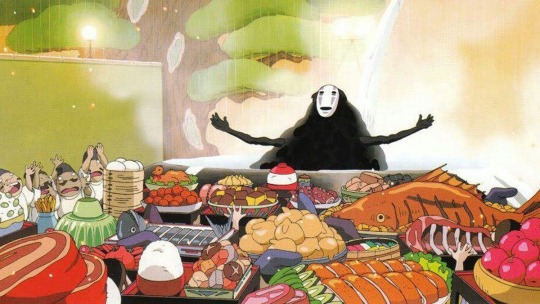

An element that is seen in nearly every Ghibli movie is food. It always holds some sort of importance in the scenes. Such as in Spirited Away, when Chihiro and her parents arrive in a mysterious town, the parents see massive amounts of irresistible food, immediately start eating it, which turns them into pigs. Or later on when No Face is given a long table of food, starts to eat it without ever feeling satisfied, and this led to the chase scene. Each of these scenes held great importance and had very terrifying effects for Chihiro.
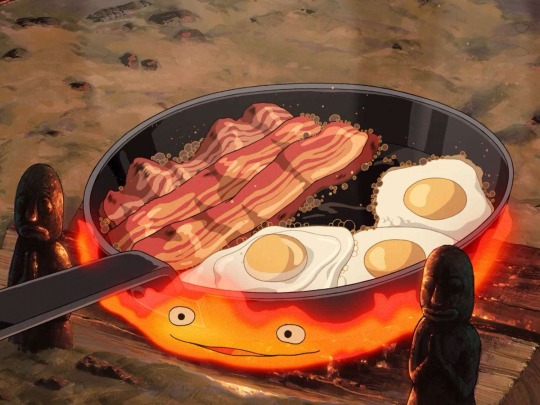
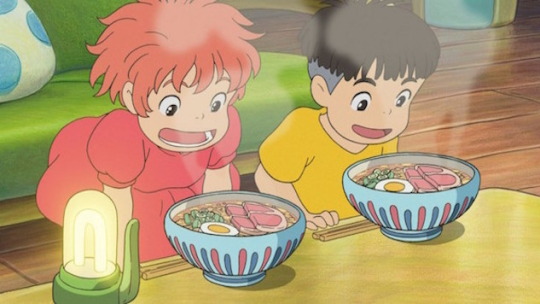
On the contrary, in Howl’s Moving Castle a very memorable scene for me, and opposite to the menacing scenes from Spirited Away, this scene is rather heart warming and comedic. Sophie tries to convince Calcifer to allow her to cook, but he’s rather stubborn and will not lower his head. Then Howl enters, and Calcifer immediately complies as Howl takes over the pan from Sophie. This scene is the first time Howl meets old Sophie in his castle, and even though she is a total stranger to him and Markly, he still invites her for the meal and without directly saying it, allows her to stay in the castle. Ghibli is known for extensive research and direct reference to the photos and videos from real life, using them in their movies. This makes all these scenes so tangible and the food looks amazingly delicious as it’s easy to image it in front of us. Food in anime is a pretty large sub-genre, and has many pages and social media accounts dedicated to just that, such as @ anime_food on instagram, which was created in 2017.Food is seen as something that ties people together, and creates a bonding moment. which is something i think i can reflect in my future work.
4 notes
·
View notes
Photo

An Adventure Hunter’s Media Guide #19
I am a HUGE fan of 99% of everything Ghibli Studios makes. Hayao Miyazaki, Isao Takahata, Toshio Suzuki, Yasuyoshi Tokuma have created some of the most epic Adventure Hunting and Adventurecore animated series ever (in my humble opinion). I was first introduced to Nausicaa/Valley of the Wind when I was a kid. It has several names. And I was hooked. Again prime Adventure Hunting and Adventurecore material: Princesses, Princes, evils Lords and Ladies, Monsters, low technology, people taking off to explore their world and save the day. Battles between good and evil. Even a great music soundtrack and score.
WARNING: Demon-Disney Co. has remastered the film a few years back and ruined it. If you are going to watch this film, look for a copy BEFORE the Disney version.
The premise of the story is very unique to the western world but is actually old in the Japanese culture at this point. Nausicaa is hardly new but despite its age, the film stands strong and age does not effect its joy, wonder, story and awesomeness. Mitazaki has created a set special world here and there are a couple of other of his work and some outside of Ghibli that could easily fit in the same world. Nausicaa/Valley of the Wind was and always will be a great Adventure Hunters/Adventurecore Go-To film for me. Specially on a day like today when its icy cold out and you want to snuggle in and watch some adventure films.
#Adventure#AdventureCore#adventure hunter#Aesthetic#aesthetics#adventure aesthetic#film#movie#Nausicaa#ghibli#valley of the wind#miyazaki
6 notes
·
View notes
Photo

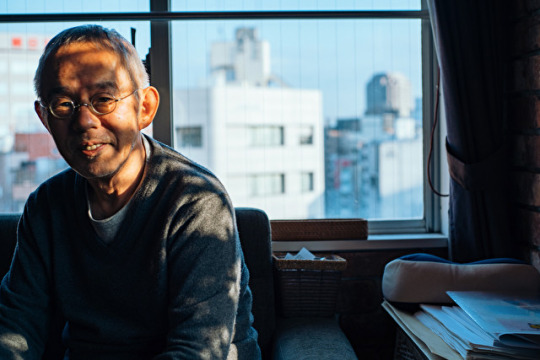
After Spirited Away, Studio Ghibli received partnership offers from the likes of Disney and DreamWorks. Ghibli turned down those offers. In the midst of an expanding animation industry, Ghibli continued as a "small movie-making workshop."
I don't know if Ghibli's financial statements are floating around out there or not, but take a look at our numbers throughout the years. They're a mess. We could turn a huge profit one year and then make 1/10 of that the next. These days every company thinks, "Next year, let's aim to make 10 percent more," right? I don't think like that. I mean, why do we have to keep growing?
This idea isn't original to me. When I started working at Tokuma Shoten [publishing company] in 1972, we didn't have that mindset. The president (Yasuyoshi Tokuma) didn't even care what our annual sales figures were. A blissful era, wasn't it?
Right now making money back through character products and DVD or VOD sales is the standard; but fundamentally for me, I'd like for the money we put into a movie to be recovered by the movie alone. If we can do that there's no need for everything else.
These days I often get asked, "Why won't you go into streaming (such as Netflix)?" But I don't want to cheapen our movies.
Even with character goods, I've always said, "Don't make them," "Don't sell them." This is often misunderstood but even the Totoro plushies weren't made until two years after the movie came out. A man named Mr. Seki from the toy company, Sun Arrow, told me, "At least give it a look," and sent me a sample, which was incredibly well made. Totoro was given such life, even Miya-san (Hayao Miyazaki), who was staunchly opposed to us making toys, was unable to deny it.
With regard to toys there was one more condition we decided on, which was "Do not sell more than 10 billion yen's worth." If a company working with us made over 10 billion yen, then at our next meeting I'd shout at the person in charge in front of everyone in the room. Seriously. One time, I was surrounded. "Let us sell more!" they said. An employee at one company told me, "At our company alone we could make over 200 billion yen." That's no joke. If we did that then before we knew it our characters would be dead. I want Ghibli characters to live long lives.
In the several years since I stopped attending these meetings, they've been breaking the 10 billion yen limit without telling me, which ticks me off a little. It's not that I'm okay with the company growing larger. It's that everyone is starting to do whatever they want. Seriously, this is no joke (laughs).
“Fighting Back Against a ‘Frivolous and Thoughtless Era’--the Heisei Period According to Ghibli’s Toshio Suzuki”
568 notes
·
View notes
Text
5 razones para amar al Studio Ghibli
5 razones para amar al @StudioGhibli.
Grandes historias de temáticas diversas, plagadas de valentía, emoción, aventura, tristeza y muchas enseñanzas que tocarán en lo más profundo tu corazón.
1. Las historias son orgánicas llevándote de la mano conociendo a los diferentes personajes y su entorno.
2. La animación que utilizan es tradicional con el mínimo de producción en ordenador.
3. Las costumbres y cultura japonesa se…
View On WordPress
#Animé#Destacado#El Viaje de Chihiro#Hayao Miyazaki#Isao Takahata#Studio Ghibli#Toshio Suzuki#Yasuyoshi Tokuma
0 notes
Quote
Studio Ghibli was born in 1985. Today is 32 years that It was created by Hayao Miyazaki, Isao Takahata, Toshio Suzuki and Yasuyoshi Tokuma. Thirty-two years with masterpieces which have filled ours hearts with feels, happiness, sadness, tenderness, nostalgic, love and ours faces have been covered with smiles and tears. But the most important thing is that we always have enjoyed their films and they will be in ours hearts forever, because their lessons about life are so real and true. This Studio arrived to my life with The Wind Rises and, in those moment, something inside me changed. A new world was born to me those day, and I'm so greatfull because I have lived and live each scene of his films and I continue loving them. Probably, I will always love them, because they were, they are and they will be special to me. So thank you, Miyazaki, Takahata, Suzuki and Tokuma for creating something that has been so beautiful and special to people.
#hayao miyazaki#isao takahata#toshio suzuki#yasuyoshi tokuma#studio ghibli#sen to chihiro no kamikakushi#howl's moving castle#el viaje de chihiro#la tumba de las luciérnagas#the graves of fireflies#naussica the valley of the wind#the wind rises#kaze tachinu#porco rosso#only yesterday#mononoke hime#kaguya hime#princess kaguya#my neighbor totoro#gake no ue no ponyo#omoide no marnie#arriety y el mundo de los diminutos#the wispers of the heart#haru in the kingdom's cats#haru en el reino de los gatos#la colina de las amapolas#kiki's delivery service#mis vecinos los yamada#pompoko#laputa castle in the sky
1 note
·
View note
Text
[ANIMAÇÃO] Studio Ghibli - Paixão por animação.
[ANIMAÇÃO] Studio Ghibli – Paixão por animação.
Já ouviram falar sobre o Studio Ghibli Animation? Ainda não?! Te convido a conhecer… (more…)
View On WordPress
#A Viagem de Chihiro#aventura#Estúdio Ghibli#feitiços#Ghibli#Hayao Miyazaki#Isao Takahata#Nausicaä do Vale do Vento#O Castelo no Céu#O Túmulo dos Vagalumes#studio ghibli#Toshio Suzuki#Yasuyoshi Tokuma
0 notes
Text
2 - Hayao Miyazaki
L’entrée de cette semaine fera office de présentation au créateur derrière les cinq films qui seront étudiés : Hayao Miyazaki. Celui-ci a fondé le studio en 1985, aux côtés des défunts Isao Takahata et Yasuyoshi Tokuma. Hélas, Miyazaki est effectivement le dernier membre de l’ensemble à l’origine du mouvement Ghibli. Bien que de nouveaux réalisateurs prennent lentement le relais au studio, incluant le fils d’Hayao – Goro Miyazaki, aucun des nouveaux films produits par cette relève n’a su atteindre le même succès et la même envergure que l’ouvrage de vie de Miyazaki.
Maintenant âgé de 80 ans, l’artiste a déjà annoncé sa retraite maintes et maintes fois. Cependant, le passionné en lui ne sait jamais quand quitter le navire; il s’est remis sur un nouveau projet, gardé secret pour l’instant… c’était plus fort que lui : « […] je ne pouvais pas contrôler ma volonté de refaire un long métrage avec l'aide de jeunes » (Ghibli.jp, 2005-2021). Force est de constater qu’Hayao Miyazaki est amoureux de son art et qu’il a un réel message à véhiculer.

Porco Rosso, 1992

Le Vent se Lève, 2013
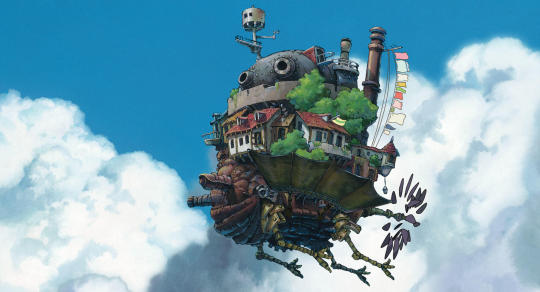
Le Château Ambulant, 2004
Les aéronefs de Miyazaki (Studio Ghibli).
Il est facile de repérer les thèmes récurrents dans les films de Miyazaki. Les avions et le vol, par exemple, constituent une sphère d’intérêt marquée du créateur, alors qu’il en explore les aspects variés dans plusieurs de ses itérations filmiques. Un second exemple serait celui du féminisme incarné à travers les héroïnes, un autre élément clé de tout film de Miyazaki. Toutefois, le thème récurrent sur lequel nous nous pencherons principalement sera celui de l’écologisme – particulièrement teinté des notions du Shintoïsme japonais dans le cas de Miyazaki – qui appartient à l’école profonde amenée par Arne Næss.
Le Shintoïsme s’avère être la deuxième religion la plus pratiquée au Japon, après le Bouddhisme; il n’est donc pas surprenant que Miyazaki y adhère de près ou de loin. Le Shintoïsme provient d’anciennes pratiques chamaniques et mêle le polythéisme à l’animisme. La croyance stipule que chaque élément de l’environnement est habité par un Kami; c’est la forme d’esprit la plus répandue au Japon. Le Kami est également perçu comme une émanation de Bouddha, qui transcende et habite tout ce qui constitue notre monde (Murasawa et Nadaud, 2013). Il est donc facile de comprendre qu’un manque de respect envers quoique ce soit – même les objets inanimés – est considéré comme une offense majeure aux yeux d’un shintoïste. Abattre un arbre, polluer une rivière ou décimer des populations animales signifie que l’on blesse ou tue des esprits perçus comme sacrés.
L’écologie profonde semble être inspirée en partie du Shintoïsme et de l’animisme. Fondée par Arne Næss dans les années 70, l’écologie profonde a pour but de rapprocher l’humain de la nature à nouveau au moyen de liens plus profonds, voire spirituels, pour s’identifier à celle-ci au-delà des simples préoccupations contemporaines, telles que la préservation d’espaces sauvages ou la lutte contre la pollution. Næss croît que chaque humain peut potentiellement accroître son soi à travers un amour inconditionnel de la nature et de la biodiversité (Charmetant, 2015). Comme Næss, Miyazaki nous invite à connecter pleinement avec la nature et à se retrouver dans un état de vénération face à elle, ce qu’il atteint à l’aide de ses films d’une grande beauté visuelle et d’esprit.
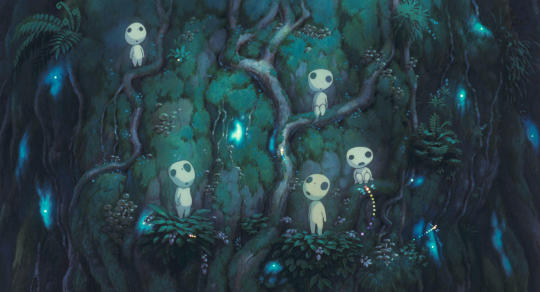
Princesse Mononoke (Studio Ghibli, 1997)
531 mots
Simon Ruggeri, 20133101
Toutes les images utilisées proviennent du site officiel du studio (https://www.ghibli.jp/)
0 notes
Text
Studio Giburi (Studio Ghibli)
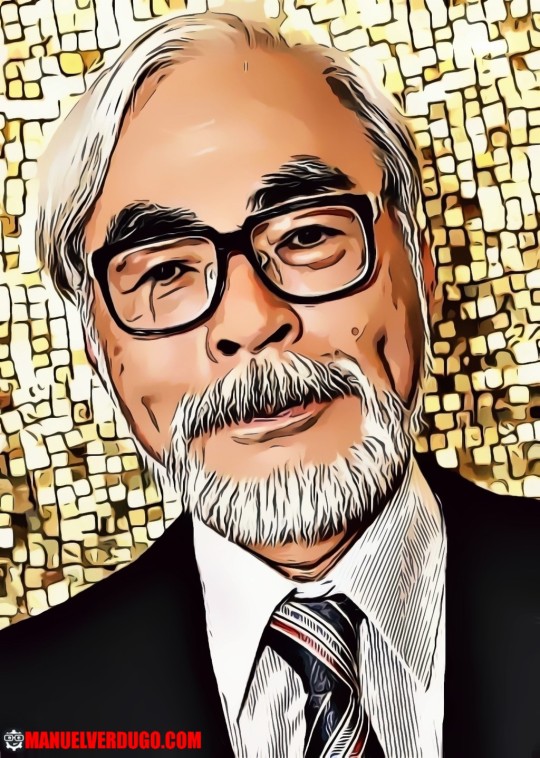
Hayao Miyazaki
El estudio Giburi; más conocido como estudio Ghibli para la comunidad hispanohablante, es una compañía japonesa de animación, fundada en mil novecientos ochenta y cuatro (1984). Considerada tanto por crítica y público, como una de las mejores productoras de animación del mundo.
Sin embargo; para explicar su origen, es necesario remontarse hasta los años sesenta, época en la que un joven animador japonés llamado Hayao Miyazaki, comienza a trabajar en la Toei Doga, un estudio de animación fundado en los años cuarenta.
Allí, conoce a Isao Takahata, otro joven que se convertirá en su amigo y compañero de por vida en Ghibli.
Su primer trabajo importante fue Horus; el príncipe del sol. Es curioso que ambos pensaran al realizar este film, que sería su último trabajo conjunto en el cine.
Aunque Horus fue un éxito gracias a un enfoque adulto, Miyazaki y Takahata se fueron del estudio y comenzaron a trabajar en A Pro, aunque por poco tiempo.
Varios proyectos suyos fracasaron como por ejemplo Pippi Calzaslargas, de la cual perdieron los derechos.
Un año después entran en Zuiyo Eizo, donde realizan dos series de muchísimo éxito, las famosísimas Heidi y Marco.
En mil novecientos ochenta y tres (1983), empezarían a producir la película que los consagraría como dos de los grandes de la animación mundial; Nausicaä del Valle del Viento.
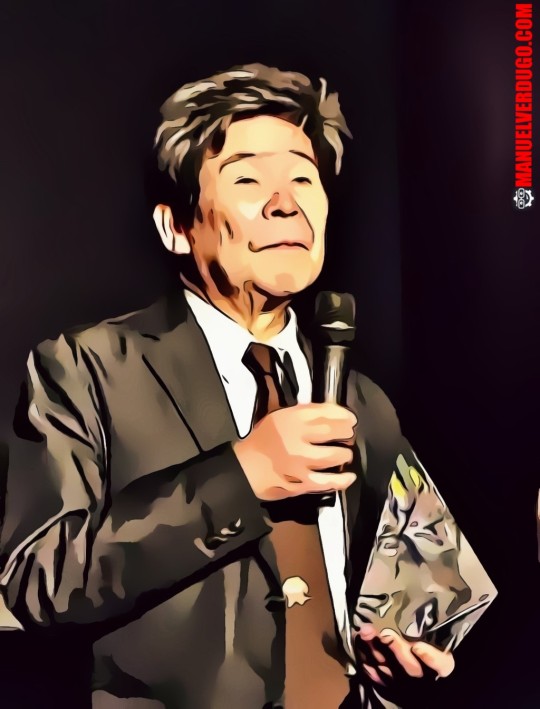
Isao Takahata
Aunque mucha gente considera a esta película como la primera de Ghibli, no es así. El equipo que trabajó en ella sería el que posteriormente integraría el estudio. Pero esta aún se realizó bajo el estudio Topcraft, con Takahata como productor y Miyazaki como director, siendo su primer largometraje.
Aparte del famoso duplo, colaboraron en la película Toshio Suzuki, como ayudante de dirección y varios colegas que Miyazaki fue conociendo en sus anteriores trabajos. Los cuales acabarían formando el grueso de Ghibli.
Nausicaä del Valle del Viento; es una adaptación de un manga del propio Miyazaki, encargado por la editorial Tokuma Shoten, la cual; al ver el éxito cosechado por la película y su altísimo nivel de realización, propuso a los dos autores la creación del Estudio Ghibli, una compañía dentro de Tokuma, que se encargaría de la producción de proyectos animados.
Como ahora sabemos, aceptaron sin dudarlo.
Le pusieron el nombre de Ghibli por los aviones italianos del mismo nombre, que sobrevolaban explorando el Sahara en la segunda guerra mundial. Deriva de la palabra italiana usada para el viento arenoso, cálido y seco del desierto.
Le pusieron dicho nombre porque querían ser un soplo de viento para la animación japonesa, que en ese momento estaba bastante estancada.
La primera premisa al crear Ghibli, era que sus producciones tendrían el presupuesto y el tiempo necesarios según lo que la película recibiera dentro de los parámetros de la empresa.
Suzuki se convirtió en el productor ejecutivo de la misma y se unieron al estudio talentos como Yasuyoshi Tokuma.

Toshio Suzuki
Miyazaki escribió una idea original para iniciar el estudio, dando lugar a El castillo en el aire, su segundo largometraje.
Al no tener que basarse en un manga, el resultado fue una película más redonda, que además; contó con más tiempo de producción. Aún así; la película no consiguió grandes ingresos económicos.
Fue entonces; cuando recuperando elementos de un proyecto anterior; Panda Kopanda, que añadiéndole ideas que había tenido de niño, Hayao creó en su tercera película el que sería su personaje más famoso y que acabaría siendo el logotipo de Ghibli; Totoro.
Mi vecino Totoro no obtuvo la confianza inicial de los productores, que la veían demasiado atrevida para ser una película infantil.
Paralela a esta, se produjo la primera película del estudio con Takahata como director; La tumba de las luciérnagas. Era una historia extremadamente adulta, seria y dura, lo cual rompía con lo que se llevaba haciendo hasta ese momento.
Gracias a la confianza de Tokuma, ambos proyectos salieron adelante, estrenándose el mismo día en una extraña y doble sesión. Ya que el tono y el público de ambos films son extremadamente diferentes.
Totoro no consiguió cubrir gastos, pero fue la primera película de estudio que probó con el merchandising.
De pronto, todos los niños tenían pequeños Totoros en sus casas. Con lo cual, no sólo consiguieron recuperar el dinero de la producción, sino que consiguieron seguir haciendo películas.
Miyazaki dirige a continuación Nicky, la aprendiz de bruja (para Latinoamérica) o Kiki: Entregas a domicilio (para España).
Aunque la crítica y el público se pusieron de acuerdo para alabar la nueva película del estudio, no obtuvo buenos resultados en taquilla.
Aprendiendo del pasado, decidieron poner en venta merchandising de Kiki, con el que volvieron a tener un gran éxito.
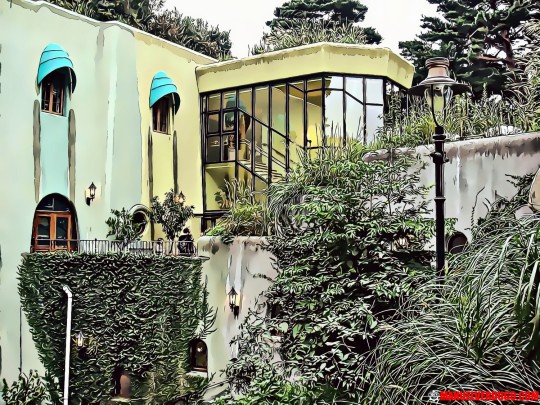
Vista desde el jardín hacia dentro del museo y estudio Ghibli
Con una seguridad económica elevada, pudieron relajarse y trabajar en un proyecto con menos riesgo del habitual. Este acabaría siendo la segunda película como director de Takahata; Recuerdos del ayer (1991). Tuvo mucho éxito en la taquilla japonesa.
A raíz de unas historias cortas, que Hayao escribió en su tiempo libre, el director realiza Porco Rosso (1992). Tuvo uno de los mejores resultados en la taquilla por parte del estudio. A partir de esta película, Studio Ghibli fue una sólida realidad. Se podía confiar en su futuro, pero no se podía dejar todo en manos de Miyazaki y Takahata y se les dieron oportunidades a otros animadores para encargarse de otros proyectos de la compañía.
Fue así como Tomomi Mochizuki, dirigió Puedo escuchar el mar, un especial para televisión que se emitía el día de los niños, siendo el único proyecto de Ghibli emitido directamente en televisión.
Intentando conseguir un volumen de trabajo mayor, para no vivir de los proyectos que hacían dos o tres años, Ghibli comenzó a buscar nuevos talentos para realizar trabajos menores del estilo del anterior y poco a poco se empezó a convertir en una empresa sin dejar de lado su filosofía y sus bases.
El siguiente proyecto fue Pompoko, la tercera película de Takahata como director y guionista. Aunque Miyazaki colaboró esbozando la historia, es junto con Nausicaä, la película más ecologista del duplo, imponiendo a la naturaleza a las fuerzas del hombre. Tema recurrente en las películas del estudio.
Susurros del corazón; fue un proyecto del director Yoshifumi Kondō, que parecía ser un sucesor de Miyazaki, por el que el estudio apostó muy fuerte. De hecho, el guion corre a cargo de este último como apoyo a Yoshifumi.
Por desgracia, el director moriría años después a causa de un aneurisma, producido por el exceso de trabajo en la próxima película del estudio, la maravillosa; La princesa Mononoke, dirigida por el incansable Miyazaki. Fue la primera película de Ghibli en utilizar efectos digitales para mejorar detalles de la animación.
Tras la muerte de su amigo, Hayao anunció su retiro del mundo del cine en mil novecientos noventa y ocho (1998) y comenzó a trabajar en el museo Ghibli, inaugurado en el dos mil uno (2001) como una zona de visita comercial en donde se proyectaban trabajos de la compañía.
Paralelo a la creación del museo, Takahata estrena su nueva película; Mis vecinos los Yamada, en mil novecientos noventa y nueve (1999). Primera película del estudio en no usar acetato para colorear su animación, ya que su director quería que parecieran acuarelas en movimiento.

Studio Ghibli
Miyazaki, tras un año de descanso decidió volver al mundillo que le apasionaba, con un nuevo film y nos regaló su gran obra maestra en dos mil uno (2001). El viaje de Chihiro se convirtió en la primera película japonesa en ganar un Oscar a mejor película de animación y superó a Mononoke en cuanto a crítica y público, convirtiéndose así posiblemente en la película más importante del estudio.
En dos mil dos (2002), Hiroyuki Morita nos trajo la primera y única secuela del estudio con Haru en El reino de los gatos (para España) o El regreso del gato (para Latinoamérica), continuación de una de las historias de Susurros del corazón. Consiguió ser la séptima película más vista del año en Japón.
La siguiente película de Ghibli volvería a contar con Miyasaki en la dirección.
El estudio cerró sus puertas seis meses para que los animadores pudieran descansar antes de enfrascarse en la película.
En ese tiempo; Miyazaki escribió el guion gráfico de la película, que acabaría estrenándose en el dos mil cuatro (2004), bajo el título de El castillo ambulante.
En dos mil seis (2006), Gorō Miyazaki, hijo de Hayao, hizo debut como director en Cuentos de Terramar, sin contar con el apoyo de su padre, que lo consideraba muy joven para hacer una película propia.
En dos mil ocho (2008) llegaría Ponyo en el acantilado (para España) o Ponyo y el secreto de la sirenita (para Latinoamérica), bajo la dirección de Hayao y se convertiría en la película más vista ese año en Japón.
Miyazaki recomendó al director Hiromasa Yonebayashi para dirigir la siguiente película del estudio, con un guion escrito por el propio Hayao, lo cual demostraba su apoyo al director.
Arrietty y el mundo de los diminutos o El mundo secreto de Arriety (2010), se convirtió en un éxito total en Japón.

Totoro; logotipo de Studio Ghibli
Ese mismo año, Suzuki reveló que se estaban produciendo dos películas más en el estudio, que serían la despedida como directores de Miyazaki y Takahata.
Gorō Miyazaki volvió a la dirección con La colina de las amapolas. Esta vez con el apoyo de su padre, que colaboró en el guion y en el diseño de los escenarios.
En dos mil doce (2012), Ghibli volvió en forma de videojuego, en una colaboración con Level-5, realizando los diseños y las escenas animadas de Ni no Kuni: La ira de la Bruja Blanca. A partir de aquí, sólo nos queda la despedida de dos grandes directores.
Miyazaki lo hizo con Se levanta el viento (para Latinoamérica) o El viento se levanta (para España) y Takahata con El cuento de la princesa Kaguya.
Unos emotivos finales por parte de los fundadores del estudio. Aunque Toshio Suzuki, en febrero del dos mil diecisiete (2017) hizo público que Hayao Miyazaki estaba de vuelta en la empresa para ser el director de ¿Cómo vives?, que se estrenará para el dos mil veintitrés (2023).
En el año dos mil catorce (2014), se estrenó el largometraje de Ghibli; El recuerdo de Marnie. Dirigido por Yonebayashi.
Después de esto Estudios Ghibli cerró sus puertas durante un tiempo indefinido para reorganizar a la plantilla y tomarse un merecidísimo descanso. Hasta que abrió sus puertas para anunciarnos el tres de junio del veinte (2020) sobre el lanzamiento de Āya to Majo, misma que está toda realizada a computadora y que se estrenaría el treinta del último mes del mismo año.
Sólo podemos esperar a que esta mágica compañía regrese de las vacaciones para poder seguir emocionándonos con sus películas. Estamos más que impacientes.
via Blogger https://ift.tt/3dx7W9A
0 notes
Text
Animators
The animation by Bernard Derriman shows that animation doesn’t have to be complex to be good. Each frame and second of this animation is smooth- I think the simplistic character design helps that aspect however it still think it’d affective even if it’s just lineart.
https://youtu.be/ENnAa7rqtBM
undefined
youtube
In the early stages of animation people used Magic lanterns back in 1645 by someone called Athanasius Kircher.

Tokyo 1985-
Four people by the name of Hayao Miyazaki, Isao Takahata, Toshio Suzuki and Yasuyoshi Tokuma founded the animation company “Studio Ghibli”. Each individual story behinf each movie was based off either a life time event or the things surrounding them. In 1996 Disney had contacted the parent company to Studio Ghibli announcing they will be distributing Princess Mononoke outside of Japan. Ideally as the years went on the animation has gradually improved and is still one of the most popular Japanese animation studios out there. Spirited away and My neighbour Totoro are two of the most popular movies with Howl’s moving castle moving up the list.

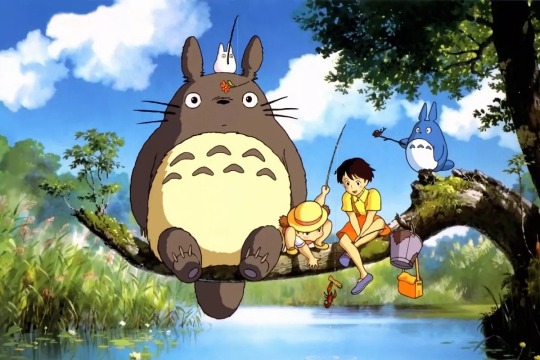
Earl Hurd-
Earl Hurd patented the Idea of cel shading around the same time John Randolph Bray had realised you do not need to animate the background like the characters- with these two ideas combined came the animation shorts studio Colonel Heezan Lair. This was then adopted by Disney in the way they animated for example Snow White and Sleeping Beauty-.


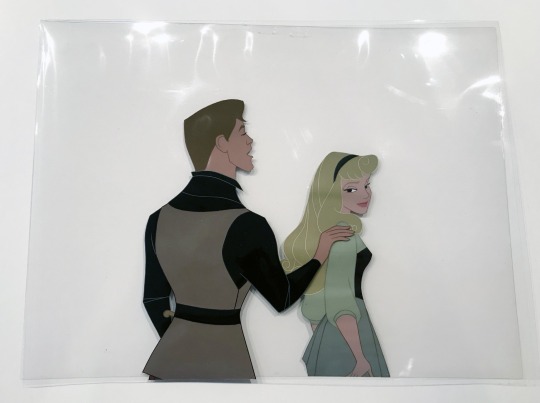
0 notes
Text
Studio Ghibli
For me and probably many others I have been captured since the start. But not just the films, the people behind it too.
Hayao Miyazaki, Isao Takahata, Joe hisashi and Toshio Suzuki.
Since Yasuyoshi Tokuma was only really a producer and a founder of the company I am not including him but rather mentioning instead.
The name means a new wind in Arabic, it was and can still be as I would hope for it’s future forwards. More importantly it was put on the map by it’s most famous person associated with the company, Hayao Miyazaki.
It almost seems whenever I watch interviews and documentaries, we would have never broaden our horizons without his genius. His way of developing a story is very intuitive. But pain painstakingly long. He smokes like an Ox, and is a small powerhouse. With the occasional attitude.
We love his work anyway. More importantly goes without saying, spirited away blew us away. Released in 2001, being the most successful and grossing film from Japan with the help of John Lassater. To then win an academy award for the best animated feature!
And so on!
Moreover we seem to forgot about how influential the other figures were behind him. So many films I have watched and absolutely loved the soundtrack!
Joe Hisaishi, ah a name to which my soul can laugh, cry, and love because of the epic music he helped bring together for the films. Now I’m not saying it was entirely his music, don’t mistake me there. But he definitely had some scores on the soundtrack. (Would have loved to his his Studio Ghibli concert in france R.I.P)
Sadly Isao Takahata passed away, a strong contender and friend to Hayao. Most people seem to have never seen his films. However, they are just as good as a contrast. His films are in a sense a tad bit more experimental in the story and art. In comparison. Moreover they take on a more human introspective view. Not to saw Hayao doesn’t do that, but it seems to me his work is more mainstream in that sense.
Finally if it wasn’t for Toshio Suzuki we wouldn’t have the Studio Ghibli we love today. After so much bad like Hayao struck it with him and his manga of Nausicaa. he’s is one of the foundrs and was once the president, he more or less focuses on producing etc.
0 notes